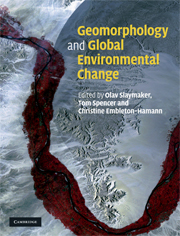Book contents
- Frontmatter
- Contents
- List of contributors
- Preface
- Acknowledgements
- List of acronyms and abbreviations
- 1 Landscape and landscape-scale processes as the unfilled niche in the global environmental change debate: an introduction
- 2 Mountains
- 3 Lakes and lake catchments
- 4 Rivers
- 5 Estuaries, coastal marshes, tidal flats and coastal dunes
- 6 Beaches, cliffs and deltas
- 7 Coral reefs
- 8 Tropical rainforests
- 9 Tropical savannas
- 10 Deserts
- 11 Mediterranean landscapes
- 12 Temperate forests and rangelands
- 13 Tundra and permafrost-dominated taiga
- 14 Ice sheets and ice caps
- 15 Landscape, landscape-scale processes and global environmental change: synthesis and new agendas for the twenty-first century
- Index
6 - Beaches, cliffs and deltas
Published online by Cambridge University Press: 05 July 2015
- Frontmatter
- Contents
- List of contributors
- Preface
- Acknowledgements
- List of acronyms and abbreviations
- 1 Landscape and landscape-scale processes as the unfilled niche in the global environmental change debate: an introduction
- 2 Mountains
- 3 Lakes and lake catchments
- 4 Rivers
- 5 Estuaries, coastal marshes, tidal flats and coastal dunes
- 6 Beaches, cliffs and deltas
- 7 Coral reefs
- 8 Tropical rainforests
- 9 Tropical savannas
- 10 Deserts
- 11 Mediterranean landscapes
- 12 Temperate forests and rangelands
- 13 Tundra and permafrost-dominated taiga
- 14 Ice sheets and ice caps
- 15 Landscape, landscape-scale processes and global environmental change: synthesis and new agendas for the twenty-first century
- Index
Summary
Introduction
Coastal areas are densely populated and highly productive regions and any changes to them could have profound direct and indirect impacts on coastal societies. The geological and historical record shows that coasts are always evolving. Hence, global environmental change (climate, sea level, water use and land use changes) expected this century (Crossland et al., 2005; IPCC, 2007a) would modify coastal evolutionary behaviour at local, regional and landscape scales with important consequences. These modifications may lead to (1) accelerations in rates of coastal change (e.g. acceleration in erosional (dominant) and accretional (exceptional) trends), (2) reversals in historical trends (e.g. accreting coasts becoming erosive), or (3) initiation of state or mode changes in coastal behaviour (e.g. dune breaching and formation of new tidal basins).
Prediction of accelerations may and should draw on historical data to extrapolate future trends in some settings. Trend reversals and state or mode changes, however, will require sufficient understanding of coastal morphodynamics to allow predictions of future change from the combined application of historical geomorphologic data and morphodynamic models. As well as best estimates, there is a need to evaluate uncertainty in terms of probabilistic risk, and to generate future scenarios to characterise consequences at different levels of risk. The objective of risk-based prediction is to express forecasts in a form that bridges the gap between science and policy. Coastal change can cause major problems for society, especially if reversal of trends and state or mode changes of behaviour occur on coasts mistakenly regarded by the community as ‘fixed’. Methodological approaches such as those outlined in this chapter are essential to explore the full range of possible changes and hence to underpin design and choice of appropriate science-based management options.
Socioeconomic changes over the coming century are expected to be so great that direct anthropogenic effects are likely to be drivers of comparable or possibly even greater significance for coastal geomorphology than climate change impacts (Valiela, 2006; IPCC, 2007b, pp. 315 – 356).
- Type
- Chapter
- Information
- Geomorphology and Global Environmental Change , pp. 158 - 179Publisher: Cambridge University PressPrint publication year: 2009
- 6
- Cited by



